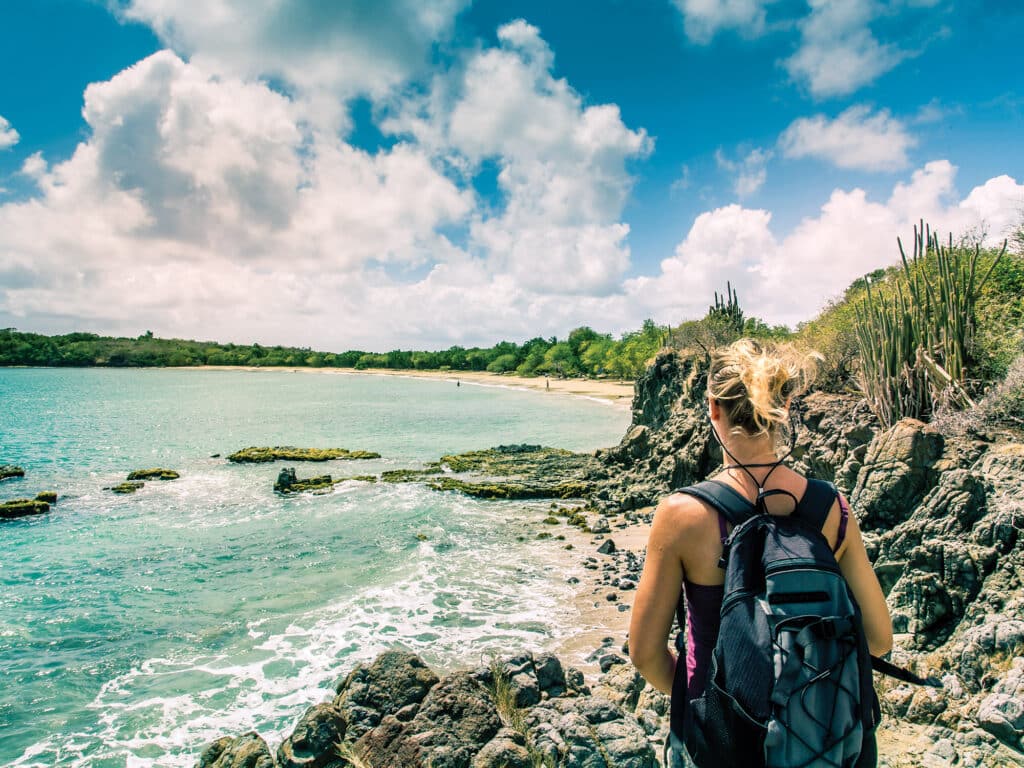
From Martinique to Grenada, the Windward Islands trace the border of the southern Caribbean Sea. They include four countries, dozens of islands—many of them uninhabited—steady trade winds, and hundreds of miles of navigable coastline. This tropical playground is an ideal sailing destination for seasoned sailors and first-time charterers alike.
At the northern end of the Windwards is Martinique, the only French territory of the group. With its fine wine, boulangeries and chic Paris fashions, it’s the island where resisting indulgence is hardest. It’s also a major yachting destination with skilled technicians, though it’s often the most expensive. Colorful colonial architecture dots the coastline, and cafes and restaurants line the beaches.
St. Lucia’s mountainous coastline beckons to the south of Martinique, with tourist destinations such as the Pitons bringing well-deserved fame. Diving and snorkeling can provide equally spectacular views underwater. There is no shortage of all-inclusive luxury resorts and romantic retreats, especially in the area around the Pitons.
St. Vincent and the Grenadines, by contrast, is where sailors get away from the crowds. The west coast of the St. Vincent mainland is rural, secluded and steep, making anchoring and mooring a challenge. Almost no yacht services are available, except at the Blue Lagoon Hotel and Marina at the southern end of the island.
From there, sailors can leave the mainland behind and head south to the Grenadines for idyllic turquoise Caribbean water. Sandy, uninhabited islets speckle the horizon. The Tobago Cays are on par with the Pitons as far as cinematic vistas, and are the destination for charter yachts.
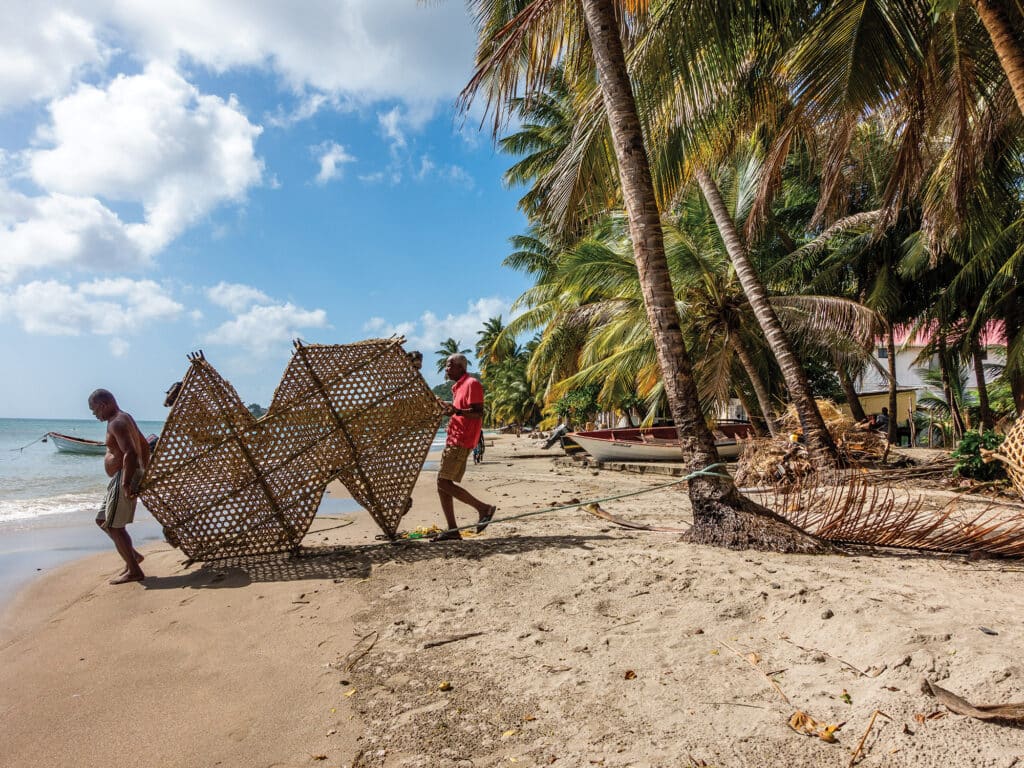
Grenada, the southernmost island in the Windwards (just outside the hurricane belt), has a charming, rural, mountainous interior flanked by palm-shaded white-sand beaches. With its abundant boatyards and marine services, Grenada is now a thriving yachting community that many sailors return to season after season.
A consistent 15- to 20-knot breeze, sunny skies and the fact that most islands are within a half day’s sail mean the options are so vast, where to go really depends on what you’re seeking. With that in mind, here are the best anchorages in the Windwards.
Best for Provisioning and Shopping
Le Marin on Martinique is a place where boulangeries and affordable French imports (yes, cheese and wine) abound. Many sailors make the hop from St. Lucia to Martinique just to go shopping.
Provisioning is made easy by services such as Appro-Zagaya and Appel à Tous, which offer provisioning, knowledgeable advice, and delivery to the dock. Appel à Tous also has an app to place an order and mark the boat’s location for delivery, whether it be on a dock, on a mooring or at anchor. If fashion is what you’re after, anchor in Fort-de-France and explore the boutique-lined streets. A short bus ride away you’ll find La Galleria and Genipa, shopping malls with chic clothing and jewelry.
Best for Diving and Snorkeling
The Tobago Cays, part of St. Vincent and the Grenadines, has a shallow, fringing reef that forms a gentle arc between sandy islets, dividing the crystalline, turquoise water from the plummeting Atlantic Ocean. Channels of white sand cut through dense reef, where damselfish dart in and out of their coral homes. Inside the reef, the anchorage encompasses a marine protected area frequented by green and hawksbill turtles. Don a mask and fins, and watch the turtles munch on seagrass, or venture out with the dinghy to Horseshoe Reef and tie onto a snorkeling mooring. (Scuba enthusiasts must dive with a local dive shop.)
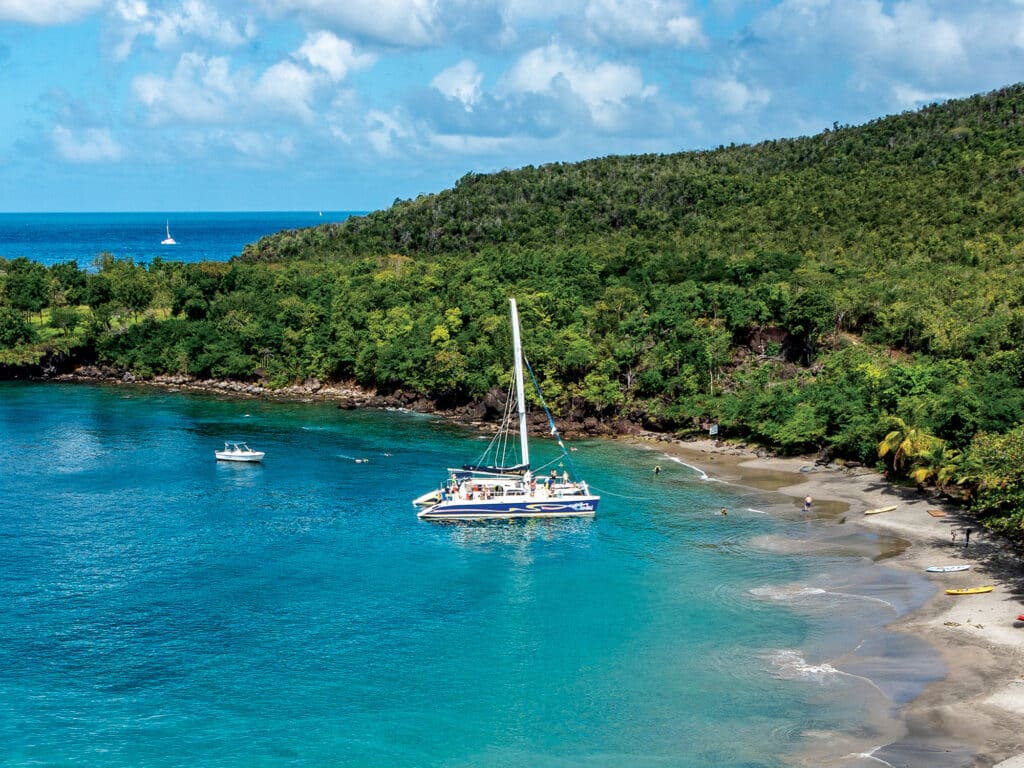
Carriacou, which belongs to Grenada, has one of the Caribbean’s most spectacular dives. Sister Rocks is northwest of Tyrell Bay, with black corals, soft gorgonians and iridescent-blue sponge vases that spill down the steep, sloping reef. The top 30 feet of ocean is often teeming with schools of baitfish or purple creole wrasse dancing in rays of sunlight. The current sweeps divers around the base of the islands as seabirds nest in craggy cliffs above. Harmless nurse sharks nestle into rocky overhangs below. This is an advanced dive with currents that can be especially strong.
St. George’s is the capital on Grenada, an island where 15 wreck-dive sites scatter the southern coast. They include the “Titanic of the Caribbean,” the Bianca C. This 600-foot cruise ship sank in 1961. Advanced divers can explore the intact swimming pool at 120 feet deep. For beginners, the Veronica L, in less than 50 feet of water, is a favorite. The site is shallow enough for light to illuminate the coral-encrusted open cargo hold and the intact crane, making for a striking scene.
Best for Hiking
Sainte-Anne is a village on Martinique, providing access to more than 100 miles of hiking trails that are mostly well-designed and -marked. Sailors can try everything from an eight-hour round-trip hike up to the summit of Mount Pelée (about 4,580 feet above sea level) to moderate trails that follow the coastline. A trailhead for the nearly 17-mile coastal Trace des Caps is in Anse Caritan, just south of Saint-Anne. The trail links a series of interesting areas to explore, including Etang des Salines, a mangrove lagoon with winding boardwalks, and Savane des Pétrifications, an arid, coastal-desert landscape reminiscent of the moon.
Soufriere and the Pitons on St. Lucia have terrain that can be moderately to extremely challenging. Gros Piton, despite its name, is the easier of the two pitons to hike, though the second half of the hike consists of steep stairs dug into the hillside. Petit Piton is shorter in elevation, but the climb is significantly steeper, much of it relying on the use of ropes to pull yourself up the cliffside. For less of a challenge and more-rewarding views, trek up Tet Paul, which offers spectacular views of both pitons, the bay below and the coastline on the other side.
Bequia’s deeply ingrained seafaring heritage is a major draw to the island, while sailors make the hop to Martinique for superb provisioning.
Grenada’s inland section is lush and mountainous, with trails that cut through tropical rainforest, along mountain ridges, and into verdant valleys of cocoa, spice and fruit plantations. There are also 18 waterfalls and a crater lake to explore. Sailors can join the Grenada Hash House Harriers, an informal hiking group that lays a different trail and meets every Saturday afternoon. Upwards of 100 sailors, expats, locals and students gather for a jovial romp through the bush, and there are almost always carpooling options to get to the trailhead.
Best for Artisans and Handicrafts
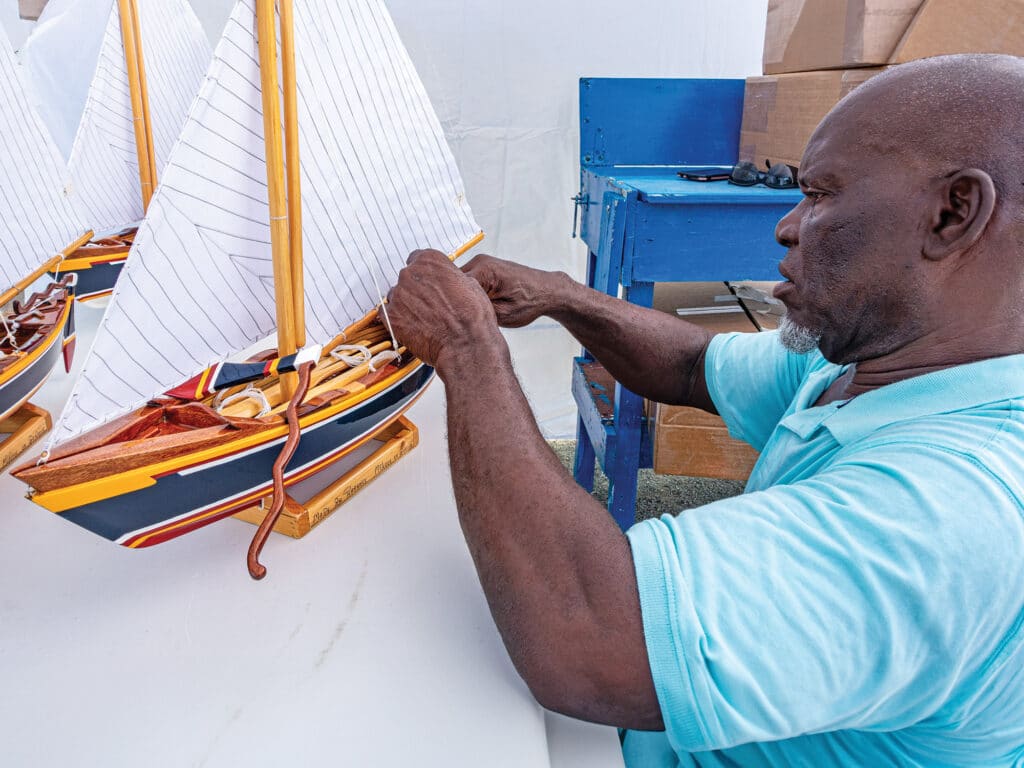
Bequia, in St. Vincent and the Grenadines, has a deeply ingrained seafaring heritage that includes whaling. It also has a long history of artisans and handicrafts, which means sailors can find great examples of scrimshaw (intricate carvings on whale bone) and model-boat building. A single boat model can take weeks to produce. Generations of skill go into everything, from selecting and felling the tree and curing the wood to painting and varnishing it, and threading delicate rigging. Most craftspeople set up stalls along the waterfront town of Port Elizabeth, where sailors also can find brightly painted calabash bowls, woven hats and baskets, coconut sculptures, and jewelry made from seeds.
Best for Nightlife
Most islands in the Windwards have annual festivals or carnivals that are worth checking out. Grenada Sailing Week at the end of January is a Caribbean Sailing Association-accredited regatta with prizes, parties and nightly live music. Serious competitors and casual cruisers alike come together for the friendly competition. The Bequia Easter Regatta in April draws an even larger crowd. Traditionally, there are events for yachts and local double-enders, and the island buzzes with newcomers and returning champions. For music lovers, the St. Lucia Jazz and Arts Festival in May is the place to be. Within the past 30 years, its genres have expanded to include reggae, pop and gospel. An array of international stars take the stage for more than a week of live performances that go on into the wee hours.
Best for Foodies
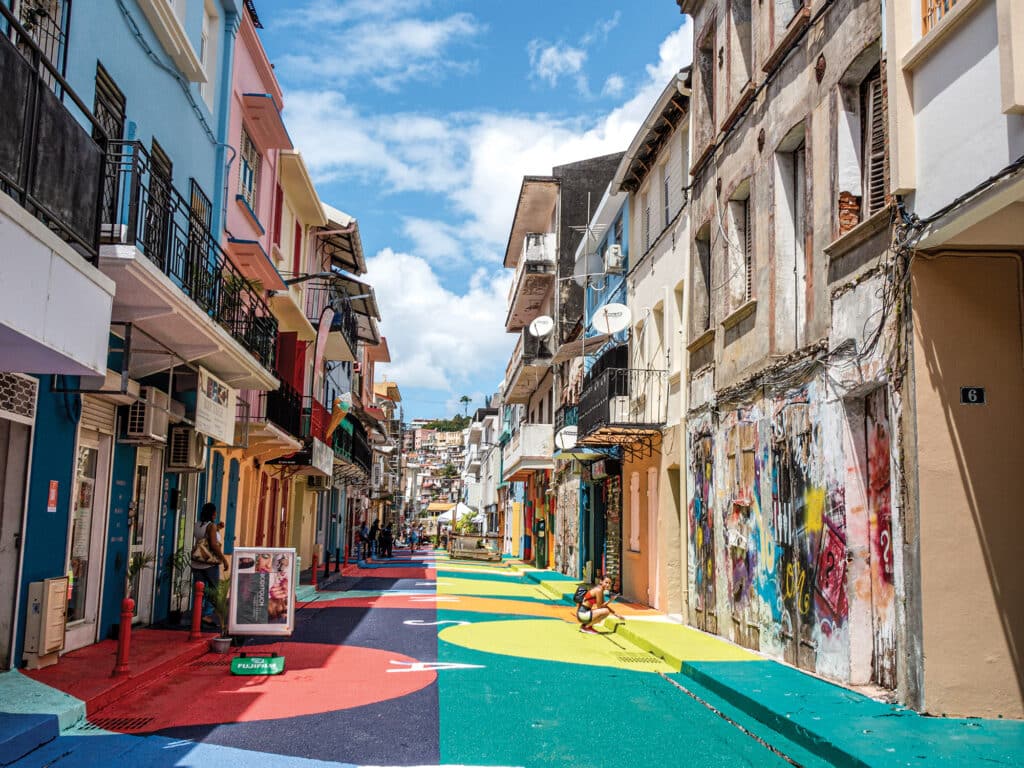
Fort-de-France on Martinique is the place to sample foie gras, caviar and escargot. Martinique has the best of the Caribbean’s fine French dining, with contemporary wine pairings and sophisticated presentations. Casual bistros and boulangeries on every corner overflow with fresh pastries. Even the simplest of lunches—a baguette layered with brie and sausage—is of a quality not found on the other Windward Islands.

Bequia, in St. Vincent and the Grenadines, has restaurants along the waterfront of Port Elizabeth. The Belmont Walkway divides the turquoise bay from bistro tables and barstools. In the Windwards, this is the widest variety of restaurants in one area, including many casual Caribbean Creole options. For a sweet treat, try Marianne’s homemade ice cream in the picturesque waterfront courtyard of the Gingerbread Hotel.
Best for Solitude
The Windward Anchorage at Mayreau, in St. Vincent and the Grenadines, has coral heads that dot a small barrier reef off the Atlantic coast. A deep channel runs along the rocky shoreline and opens up into a sandy bay inside the reef. With only the Tobago Cays in the distance, the wind blows unencumbered across the glistening sea. A single restaurant ashore provides the only connection to the outside world, offering the convenience of not cooking if the anchorage gets too rolly.
Sandy Island is part of Grenada. Not to be confused with Sandy Island in Carriacou, it lies just off Grenada’s northern coast. The island is surrounded by a shallow coral reef. Boats need a shallow draft and skippers need a sharp eye to make it through the narrow, 5-foot-deep channel into this secluded, one-boat anchorage.
White Island at Carriacou, also part of Grenada, has windswept vegetation that spills from a rocky pinnacle overlooking the Atlantic Ocean, tapering to a small peninsula of fine white sand. Both this island and its neighbor, Saline Island, are uninhabited, but Saline can be popular and crowded. By contrast, sailors usually have White Island to themselves, perhaps because anchoring can be difficult on the edge of the deep channel between reefs.
Best in a Big Blow
Grenada’s Port Egmont has a deep bay on the Atlantic coast. It takes a dogleg as the coastline transitions from rocky scrubland to thick mangroves. The entrance to the outer bay is reef-strewn and can be tricky, especially in a swell, but inside, there’s a deep lagoon that provides shelter from the surge. Port Egmont is the best option when offshore hurricanes disrupt the regular trade winds, and the prevailing wind and surge swing to the west.
Tyrell Bay at Carriacou is a long and winding mangrove lagoon that’s one of the best hurricane holes in the Caribbean, especially for shallow-draft vessels that can make it through the 4-foot-deep bottleneck into the inner bay. A wide, dense perimeter of mangrove forest protects the inner lagoon from heavy winds and surge. The lagoon is part of the Sandy Island/Oyster Bed marine protected area, and is accessible only under threat of a named storm.
Le Marin at Martinique is a deep, sprawling bay where mangrove lagoons finger off into 10 to 20 feet of water, deep enough for most yachts to tuck in and ride out a storm. The innermost bay is further protected from the wind by hills on either side. Anchoring in the mangrove lagoons is permitted only under threat of a hurricane, and the lagoons tend to fill up fast, as Le Marin is the yachting capital of Martinique.
Best for a Last-Minute Haulout
Grenada has three large boatyards and many skilled, affordable technicians. If you’re coming from the north, and if time and distance are a major factor, then Grenada’s sister island of Carriacou is a day’s sail closer and might be the better choice. Carriacou has two haulouts, both in the main anchorage of Tyrell Bay, where most yacht services are located. Though Carriacou’s selection of services isn’t as vast as Grenada’s, parts can often be brought up within a day or two.
Martinique is an option in the northern end of the Windwards. Le Marin is the island’s center of yachting. Though there is only one yard, it is large and well-equipped. Parts and technicians are top-notch, with a price tag to match. The nation’s capital, Fort-de-France, also has a boatyard. It is geared more toward motoryachts, and it’s a good choice for engine or mechanical issues.
In all of these destinations, the time of year will affect space and availability. At the beginning and end of hurricane season (May and November), many boatyards are booked up months in advance. Some make space for a quick haul and launch in an emergency.








